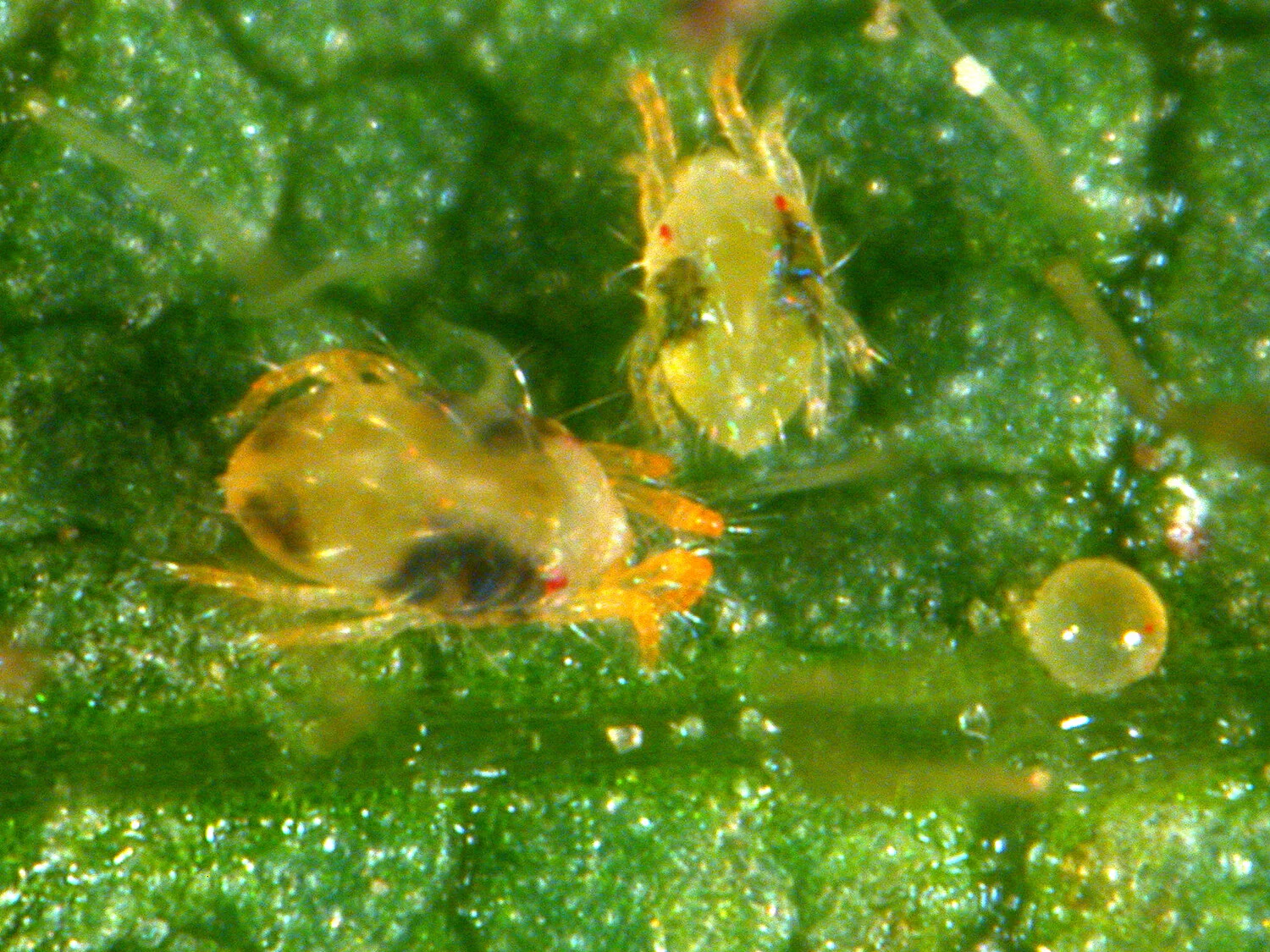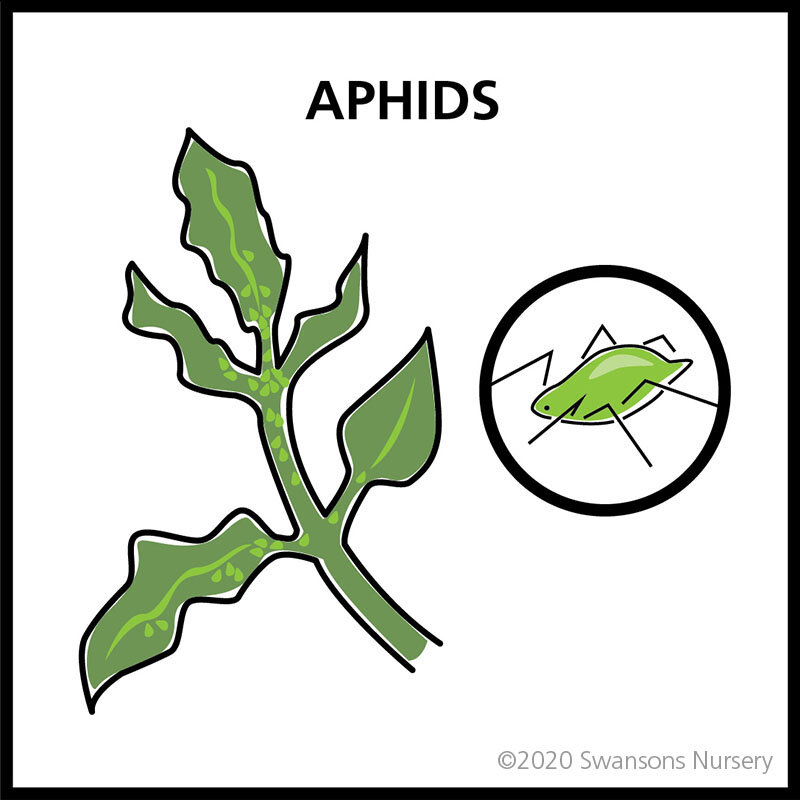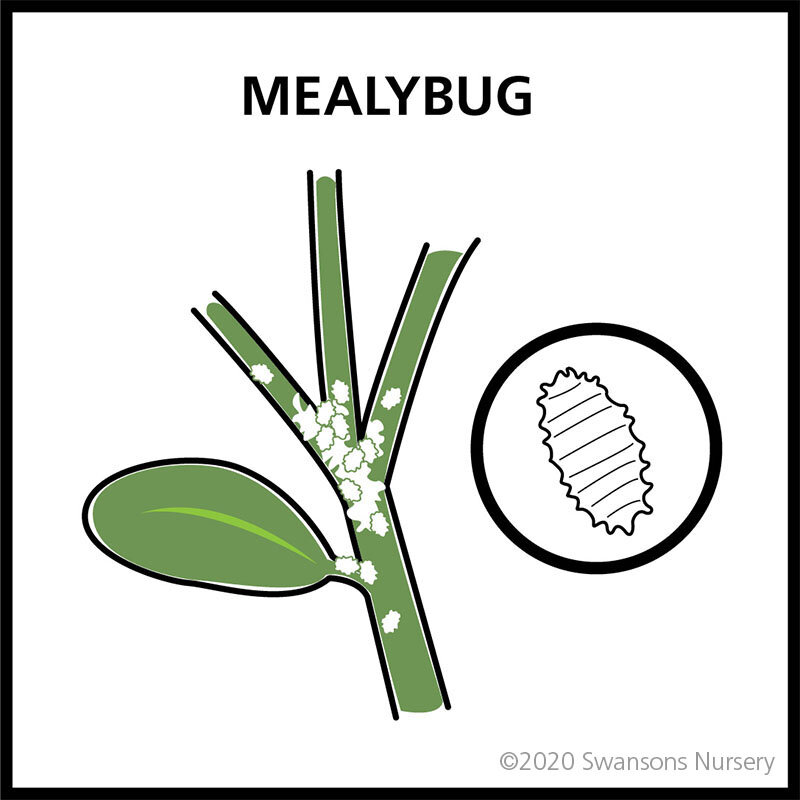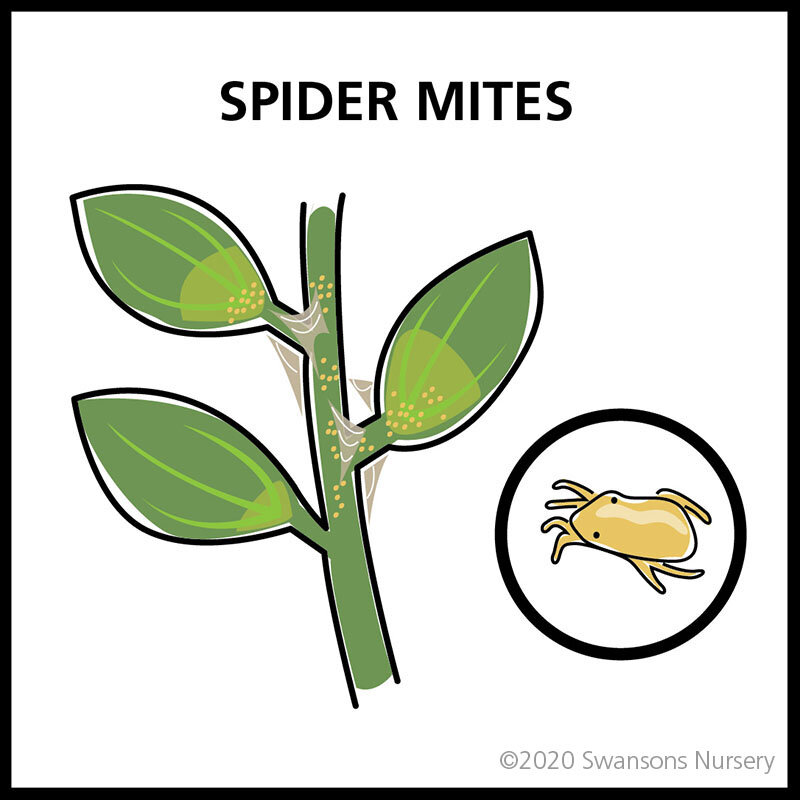You know the feeling. Your plant baby is doing great and growing when all of a sudden you notice something’s not right. Could it be watering? A draft? Too much sun or not enough?
While some issues are care related, like over- or under-watering, sometimes the culprit is a pest attack. Whether you find them panic-inducing, fascinating, or just plain disgusting, houseplant pests are definitely not welcome on your babies. Don’t despair! There are many options for dealing with pests and, in many cases, they can be eradicated and your plant can be restored to health. But how to decide which pest is attacking? Where to start trying to get rid of them?
We’re here to help. In this post, you’ll learn about the most common houseplant pests, how to spot them, and what you can do to get rid of them (you can click on the * after a product to see our glossary of pest products).
Aphids
You may have noticed aphids on your outdoor plants before but did you know they can also attack indoor plants? These soft-bodied insects suck nutrient-rich juices out of leaves and can cause the plant to lose vigor.
What to look for:
Wrinkled or curled leaves
Sticky residue
Masses of tiny grey, black, or translucent green bugs, especially on the undersides of leaves
How to stop them:
First steps: Gently wash the leaves of the plant with soapy water or wipe with rubbing alcohol to remove these soft-bodied insects. You can also try spraying the plant with insecticidal soap.*
Drastic measures: If pest problems persist, a systemic insecticide* might be needed. We recommend Bonide Systemic Insect Control, a powder applied to the soil and watered in.
Fungus Gnats
While fungus gnats are annoying, they generally don’t cause damage to plants. Gnats lay eggs in the soil and larvae hatch and eat organic matter in the soil. Getting rid of them for good requires killing both adults and larvae to break the cycle.
What to look for:
Small black or dark brown flying insects circling the plant
May fly out of the soil when you are watering plants
Soggy, wet soil
How to stop them:
First steps: Fungus gnats love moist conditions so make sure the surface of your plant’s soil dries out somewhat before watering again and don’t let plants sit in water. To learn more about watering your plants, click here. Covering the top of your soil with decorative sand keeps the gnats from laying eggs (however, this can make it harder to tell when you need to water). Yellow sticky traps can also help trap adults.
Drastic measures: Products that contain the natural bacterial pesticide Bacillus thuringiensis var. israelensis,* such as Mosquito Bits, can kill the larvae and is non-toxic to people and pets. Drenching the soil with Neem Oil* has also proven effective in killing larvae.
Scale
Scale insects are common houseplant pests that can often just look like small bumps on a stem or the undersides of leaves. These pests grow beneath a waxy “shell,” feed on sap, and secrete a sticky residue on which sooty mold can grow. Females can lay between 50 to 2,000 eggs under their “shell”! Not good.
What to look for:
Small, smooth, grey, white, yellow, black, or reddish-brown bumps on the surface of leaves and stems
Bumps can easily be scraped off with a fingernail
Sticky residue with sooty mold
How to stop them:
First steps: Scrape off pests by hand or wipe off with a Q-tip soaked in alcohol. Gently wash the residue off leaves with soapy water. Applying horticultural oil* to the leaves and stems can help smother scale insects.
Drastic measures: If scale continues to be a problem, a systemic insecticide* is needed. Severely infested plants that don’t respond to a systemic may need to be thrown away (good thing Swansons has a plant replacement guarantee - no questions asked!)
Mealybugs
The name says it all. Yuck. Although they really look more fluffy than mealy… In any case, these soft-bodied insects are covered in a waxy, cottony coating that protects them. They are often found in moist, warm habitats and love sucking the juices out of your houseplants.
What to look for:
Fluffy, greyish-white insects on the undersides of leaves and stems
Sticky residue with sooty mold
Yellowing, wilting, or general plant decline
Spider Mites
Spider mites didn’t get their name just because they make webs. They are actually related to spiders, ticks, daddy-longlegs, and scorpions! Luckily, they are so tiny they are barely visible to the naked eye and not prone to biting humans. However, spider mites feed on the underside of leaves, removing the chlorophyll that gives them their green color, which is why you may see beige stippling.
What to look for:
Tiny beige dots stippling leaves
Fine webbing on leaves and stems
Yellowing and dropping leaves
How to stop them:
First steps: Wash mites and webbing off the plant with soapy water. You can also wipe down the plant with rubbing alcohol. Mites like warm, dry conditions and often appear when indoor heat starts running in the fall. Mist plants or add trays of water to increase humidity.
Drastic measures: If you continue to see mites, apply horticultural oil.* For a severe infestation, it may be necessary to discard the plant. Remember, plants purchased at Swansons are guaranteed and we will gladly replace them if they go to plant heaven.
Thrips
Thrips are tiny, winged insects that can be very difficult to spot with the naked eye so you might think you’re just seeing a little bit of dust or dirt until you see it move. Adults may be black or brown but larvae are often white or light green. They puncture the outer layer of plant leaves and suck up all the juices. Lovely. Luckily, most mature houseplants can survive an infestation.
What to Look For:
Tiny white or brown ovals moving along the leaves (a magnifying glass can help you spot them)
Blotchy brown or silvery discoloration on the plant and yellowing or fading leaves
Tiny black specks of thrip excrement (yuck!)
How to Stop Them:
First Steps: Rinse the leaves and stems of your plant gently under running water or use a spray bottle of water and a soft rag to spritz and wipe down the leaves. Then, spray leaves with organic insecticidal soap* or neem oil.*
Drastic Measures: For larger infestation, and to control larvae and eggs in the soil, a systemic insecticide* may be called for. This product will soak into the plant’s soil and be drawn up into the plant itself, poisoning the thrips as they feed.
Houseplant Pest Infographic
Download or print this handy infographic so you can spot the signs of indoor plant infestations. Remember, the best defense against pests are strong, healthy plants. That said, pests aren’t necessarily a sign of bad plant parenting, so don’t feel guilty! With a little patience and thoroughness, you can battle houseplant pests and win.
Still have questions? We’re happy to offer pest IDs, troubleshooting, and advice! Just reach out on social media using hashtag #heyswansons or comment on this post.
A few important notes & a glossary of terms
When you bring a new plant home, inspect it for any signs of insects and keep it isolated from your other plants if you suspect pests. And remember, Swansons will always be happy to replace your plant for any reason.
This blog post is meant to help identify pests and offer treatment options. Always follow the instructions on the label of the remedy you choose to be sure you are using it correctly and safely. When using sprays or oils, we recommend testing the product for 24 hours on one leaf to be sure the plant reacts well to the treatment.
Pesticides are chemicals that may be used to kill fungus, bacteria, insects, plant diseases, slugs, weeds, and other “pests.” Insecticides are a type of pesticide that is used to specifically target and kill insects.
Insecticidal Soap is a natural insecticide, generally made of potassium salts of fatty acids. Fatty acids are extracted from palm, coconut, olive, castor, and cottonseed plants. When soft-bodied insects are sprayed with insecticidal soap their cell membranes are disrupted and cell contents leak, causing the insects to perish. Insecticidal soap is not considered toxic to humans or animals. They are not recommended for plants with fuzzy, hairy leaves.
Neem Oil is a naturally occurring pesticide found in the seeds of the neem tree. It works by interrupting the life cycle of chewing and sucking insects, turning off the hormones that tell an insect feed and mate. It can also repel insects. Neem oil can be irritating to the skin and stomach, so do not ingest. It is considered non-toxic to humans and animals. Do not use neem oil on cacti and succulents.
Horticultural Oil is a lightweight oil made from petroleum, mineral oil, or vegetable oils. It works by suffocating the insects it coats and must be sprayed directly on pests to be effective. It is considered safe to use around humans and animals.
Bacillus thuringiensis subspecies israelensis is a naturally occurring bacterium found in soil. It contains spores that produce toxins that specifically target and only affect the larvae of the mosquito, blackfly, and fungus gnat. It is considered non-toxic to humans and animals.
Systemic Insecticides are chemicals that are soluble in water and can be absorbed by a plant and move through all its tissues. Since these insecticides are made of chemicals, they are hazardous to humans and animals if ingested or absorbed through the skin. Bonide Systemic Insect Control is a powder that is applied to the soil and watered in.







